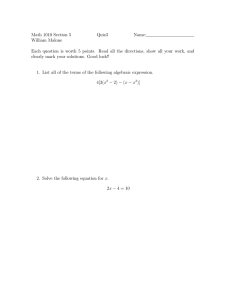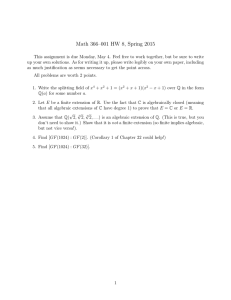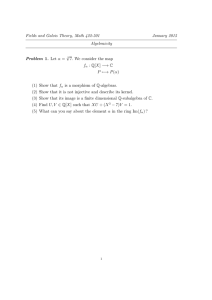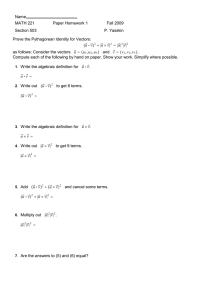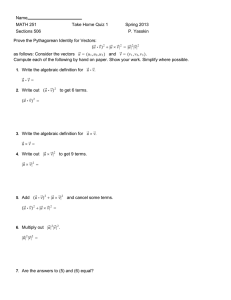18.782 Introduction to Arithmetic Geometry Fall 2013 Lecture #12 10/17/2013
advertisement
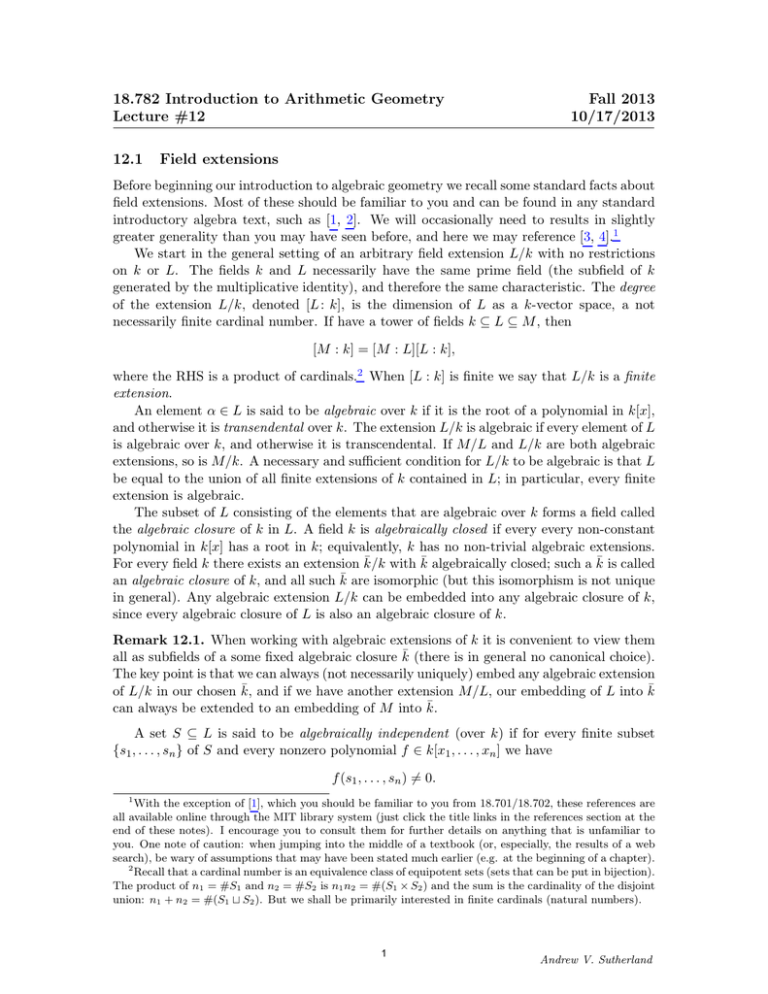
18.782 Introduction to Arithmetic Geometry
Lecture #12
12.1
Fall 2013
10/17/2013
Field extensions
Before beginning our introduction to algebraic geometry we recall some standard facts about
field extensions. Most of these should be familiar to you and can be found in any standard
introductory algebra text, such as [1, 2]. We will occasionally need to results in slightly
greater generality than you may have seen before, and here we may reference [3, 4].1
We start in the general setting of an arbitrary field extension L/k with no restrictions
on k or L. The fields k and L necessarily have the same prime field (the subfield of k
generated by the multiplicative identity), and therefore the same characteristic. The degree
of the extension L/k, denoted [L : k], is the dimension of L as a k-vector space, a not
necessarily finite cardinal number. If have a tower of fields k ⊆ L ⊆ M , then
[M : k] = [M : L][L : k],
where the RHS is a product of cardinals.2 When [L : k] is finite we say that L/k is a finite
extension.
An element α ∈ L is said to be algebraic over k if it is the root of a polynomial in k[x],
and otherwise it is transendental over k. The extension L/k is algebraic if every element of L
is algebraic over k, and otherwise it is transcendental. If M/L and L/k are both algebraic
extensions, so is M/k. A necessary and sufficient condition for L/k to be algebraic is that L
be equal to the union of all finite extensions of k contained in L; in particular, every finite
extension is algebraic.
The subset of L consisting of the elements that are algebraic over k forms a field called
the algebraic closure of k in L. A field k is algebraically closed if every every non-constant
polynomial in k[x] has a root in k; equivalently, k has no non-trivial algebraic extensions.
¯ with k¯ algebraically closed; such a k¯ is called
For every field k there exists an extension k/k
¯
an algebraic closure of k, and all such k are isomorphic (but this isomorphism is not unique
in general). Any algebraic extension L/k can be embedded into any algebraic closure of k,
since every algebraic closure of L is also an algebraic closure of k.
Remark 12.1. When working with algebraic extensions of k it is convenient to view them
all as subfields of a some fixed algebraic closure k¯ (there is in general no canonical choice).
The key point is that we can always (not necessarily uniquely) embed any algebraic extension
¯ and if we have another extension M/L, our embedding of L into k¯
of L/k in our chosen k,
¯
can always be extended to an embedding of M into k.
A set S ⊆ L is said to be algebraically independent (over k) if for every finite subset
{s1 , . . . , sn } of S and every nonzero polynomial f ∈ k[x1 , . . . , xn ] we have
f (s1 , . . . , sn ) 6= 0.
1
With the exception of [1], which you should be familiar to you from 18.701/18.702, these references are
all available online through the MIT library system (just click the title links in the references section at the
end of these notes). I encourage you to consult them for further details on anything that is unfamiliar to
you. One note of caution: when jumping into the middle of a textbook (or, especially, the results of a web
search), be wary of assumptions that may have been stated much earlier (e.g. at the beginning of a chapter).
2
Recall that a cardinal number is an equivalence class of equipotent sets (sets that can be put in bijection).
The product of n1 = #S1 and n2 = #S2 is n1 n2 = #(S1 × S2 ) and the sum is the cardinality of the disjoint
union: n1 + n2 = #(S1 t S2 ). But we shall be primarily interested in finite cardinals (natural numbers).
1
Andrew V. Sutherland
Note that this means the empty set is algebraically independent (just as the empty set
is linearly independent in any vector space). An algebraically independent set S ⊆ L for
which L/k(S) is algebraic is called a transcendence basis for the extension L/k.
Theorem 12.2. Every transcendence basis for L/k has the same cardinality.
Proof. We will only prove this in the case that L/k has a finite transcendence basis (which
includes all extensions of interest to us); see [3, Theorem 7.9] for the general case. Let
S = {s1 , . . . , sm } be a smallest transcendence basis and let T = {t1 , . . . , tn } be any other
transcendence basis, with n ≥ m. The set {t1 , s1 , . . . , sm } must then algebraically dependent, since t1 ∈ L is algebraic over k(S), and since t1 is transcendental over k, some si , say s1 ,
must be algebraic over k(t1 , s2 , . . . , sm ). It follows that L is algebraic over k(t1 , s2 , . . . , sm ),
and the set T1 = {t1 , s2 , . . . , sm } must be algebraically independent, otherwise it would
contain a transcendence basis for L/k smaller than S. So T1 is a transcendence basis for
L/k of cardinality m that contains t1 .
Continuing in this fashion, for i = 2, . . . , m we can iteratively construct transcendence
bases Ti of cardinality m that contain {t1 , . . . , ti }, until Tm ⊆ T is a transcendence basis of
cardinality m; but then we must have Tm = T , so n = m.
Definition 12.3. The transcendence degree of a field extension L/K is the cardinality of
any (hence every) transcendence basis for L/k.
Unlike extension degrees, which multiply in towers, transcendence degrees add in towers:
for any fields k ⊆ L ⊆ M , the transcendence degree of M/k is the sum (as cardinals) of the
transcendence degrees of M/L and L/k.
We say that the extension L/k is purely transcendental if L = k(S) for some transcendence basis S for L/k. All purely transcendental extensions of k with the same transcendence degree are isomorphic. Every field extension L/k can be viewed as an algebraic
extension of a purely transcendental extension: if S is a transcendence basis of L/k then
L/k(S) is an algebraic extension of the purely transcendental extension k(S)/k.
Remark 12.4. It is not the case that every field extension is a purely transcendental
extension of an algebraic extension. Indeed, there are already plenty of counterexamples
with transcendence degree 1, as we shall soon see.
The field extension L/k is said to be simple if L = k(x) for some x ∈ L. A purely
transcendental extension of transcendence degree 1 is obviously simple, but, less trivially,
so is any finite separable extension (see below for the definition of separable); this is known
as the primitive element theorem.
Remark 12.5. The notation k(x) can be slightly confusing. If x ∈ L is transcendental
over k then k(x) is isomorphic to the field of rational functions over k, in which case we
may as well regard x as a variable. But if x ∈ L is algebraic over k, then every rational
expression r(x) with nonzero denominator can be simplified to a polynomial in x of degree
less than n = [k(x) : k] by reducing modulo the minimal polynomial f of x (note that
we can invert nonzero denominators modulo f ); indeed, this follows from the fact that
{1, x, . . . , xn−1 } is a basis for the n-dimensional k-vector space k(x).
2
12.1.1
Algebraic extensions
We now assume that L/k is algebraic and fix k¯ so that L ∈ k̄. The extension L/k is normal
if it satisfies either of the equivalent conditions:
• every irreducible polynomial in k[x] with a root in L splits completely in L;
• σ(L) = L for all σ ∈ Aut(k/k) (every automorphism of k that fixes k also fixes L).3
Even if L/k is not normal, there is always an algebraic extension M/L for which M/k is
normal. The minimal such extension is called the normal closure of L/k; it exists because
intersections of normal extensions are normal. It is not true in general that if L/k and M/L
are normal extensions then so is M/k, but if k ⊆ L ⊆ M is a tower of fields with M/k
normal, then M/L is normal (but L/k need not be).
A polynomial f ∈ k[x] is separable if any of the following equivalent conditions hold:
¯ are all distinct;
• the factors of f in k[x]
¯
• f and f 0 have no common root in k;
• gcd(f, f 0 ) = 1 in k[x].
An element α ∈ L is separable over k if any of the following equivalent conditions hold:
• α is a root of a separable polynomial f ∈ k[x];
• the minimal polynomial of α is separable;
• char(k) = 0 or char(k) = p > 0 and the minimal polynomial of α is not of the form
g(xp ) for some g ∈ k[x].
The elements of L that are separable over k form a field called the separable closure of k
in L. The separable closure of k in its algebraic closure k¯ is denoted k sep and is simply
called the separable closure of k. If k ⊆ L ⊆ M then M/k is separable if and only if both
M/L and L/k are separable.
A field k is said to be perfect if any of the following equivalent conditions hold:
• char(k) = 0 or char(k) = p > 0 and k = {xp : x ∈ k} (k is fixed by Frobenius);
• every finite extension of k is separable over k;
• every algebraic extension of k is separable over k.
Note that finite fields and all fields of characteristic 0 are perfect.
Example 12.6. The rational function field k = Fp (t) is not perfect. If we consider the finite
extension L = k(t1/p ) obtained by adjoining a pth root of t to k, the minimal polynomial
of t1/p is xp − t, which is irreducible over k but not separable (its derivative is 0).
An algebraic extension L/k isGalois if it is both normal and separable, and in this case
we call Gal(L/k) = Aut(L/k) the Galois group of L/k. The extension k sep /k is always
normal: if an irreducible polynomial f ∈ k[x] has a root α in k sep , then (up to scalars) f
is the minimal polynomial of α over k, hence separable over k, so all its roots lie in k sep .
Thus k sep /k is a Galois extension and its Galois group
Gk = Gal(k sep /k)
3
Some authors write Gal(L/k) for Aut(L/k), others only use Gal(L/k) when L/k is known to be Galois;
we will use the later convention.
3
¯
is the absolute Galois group of k (we could also define Gk as Aut(k/k),
the restriction map
sep
¯
from Aut(k/k) to Gal(k /k) is always an isomorphism).
The splitting field of a polynomial f ∈ k[x] is the extension of k obtained by adjoining
¯ Every splitting field is normal, and every finite normal
all the roots of f (which lie in k).
extension of k is the splitting field of some polynomial over k; when k is a perfect field we
can go further and say that L/k is a finite Galois extension if and only if it is the splitting
field of some polynomial over k.
For finite Galois extensions M/k we always have #Gal(M/k) = [M : k], and the fundamental theorem of Galois theory gives an inclusion-reversing bijection between subgroups
H ⊆ Gal(M/k) and intermediate fields k ⊆ L ⊆ M in which L = M H and H = Gal(M/L)
(note that M/L is necessarily Galois). Beware that none of the statements in this paragraph
necessarily applies to infinite Galois extensions, some modifications are required (this will
be explored further on the next problem set).
12.2
Affine space
¯
Let k be a perfect field and fix an algbebraic closure k.
Definition 12.7. n-dimensional affine space over k is the set
Ank = {(x1 , . . . , xn ) ∈ k̄ n },
equivalently Ank is the vector space k¯n regarded as a set. When k is clear from context we
may just write An . If k ⊆ L ⊆ k̄, the set of L-rational points (or just L-points) in An is
¯ GL ,
An (L) = {(x1 , . . . , xn ) ∈ Ln } = An (k)
¯ GL denotes the set of points in An (k)
¯ fixed by GL = Gal(Lsep /L) = Gal(k/L).
¯
where An (k)
n
n
G
¯
In particular, A (k) = A (k) k .
¯ 1 , . . . , xn ], the set of points
Definition 12.8. If S is a set of polynomials in A = k[x
ZS = {P ∈ An : f (P ) = 0 for all f ∈ S},
¯ the set of L-rational points in ZS is
is called an (affine) algebraic set. If k ⊆ L ⊆ k,
ZS (L) = ZS ∩ An (L).
When S is a singleton {f } we may write Zf in place of Z{f } .
Note that if I is the A-ideal generated by S, then ZI = ZS , since f (P ) = g(P ) = 0
implies (f + g)(P ) = 0 and f (P ) = 0 implies (f g)(P ) = 0. Thus we can always replace S
by the ideal (S) that it generates, or by any set of generators for (S).
Example 12.9. We have Z∅ = Z(0) = An and Z{1} = Z(1) = ∅.
For any S, T ⊆ A we have
S⊆T
=⇒
ZT ⊆ ZS ,
but the converse need not hold, even if S and T are ideals: consider T = (x1 ) and S = (x21 ).
We now recall the notion of a Noetherian ring and the Hilbert basis theorem.
4
Definition 12.10. A commutative ring R is noetherian if every R-ideal is finitely generated.4 Equivalently, every infinite ascending chain of R-ideals
I1 ⊆ I2 ⊆ · · ·
eventually stabilizes, that is, In+1 = In for all sufficiently large n.
Theorem 12.11 (Hilbert basis theorem). If R is a noetherian ring, then so is R[x].
Proof. See [1, Theorem 14.6.7] or [2, Theorem 8.32].
Note that we can apply the Hilbert basis theorem repeatedly: if R is noetherian then
so is R[x1 ], and so is (R[x1 ])[x2 ] = R[x1 , x2 ], . . . , and so is R[x1 , . . . , xn ]. Like every field,
k̄ is a noetherian ring (it has just two ideals, so it certainly satisfies the ascending chain
¯ 1 , . . . , xn ] is noetherian, so every A-ideal is finitely generated. It
condition). Thus A = k[x
follows that every algebraic set can be written in the form ZS with S finite.
Definition 12.12. For an algebraic set Z ⊆ An , the ideal of Z is the set
I(Z) = {f ∈ A : f (P ) = 0 for all P ∈ Z},
¯ 1 , . . . , xn ].
where A is the polynomial ring k[x
The set I(Z) is clearly an A-ideal (it is closed under addition and under multiplication
by elements of A), and we note that
Y ⊆Z
I(Z) ⊆ I(Y )
=⇒
and
I(Y ∪ Z) = I(Y ) ∩ I(Z)
(both statements are immediate from the definition).
We have Z = ZI(Z) for every algebraic set Z, but it is not true that I = I(ZI ) for every
ideal I. As a counterexample, consider I = (f 2 ) for some polynomial f ∈ A. In this case
I(Z(f 2 ) ) = (f ) 6= (f 2 ).
In order to avoid this situation, we want to restrict our attention to radical ideals.
Definition 12.13. Let R be a commutative ring. For any R-ideal I we define
√
I = {x ∈ R : xr ∈ I for some integer r > 0},
√
and say that I is a radical ideal if I = I.
√
Lemma 12.14. For any ideal I in a commutative ring R, the set I is an ideal.
√
√
r
r r
r
Proof.
√ Let x ∈s I with x ∈ I. For any y ∈ R we have y x = (xy) ∈ I, so xy ∈ I. If
y ∈ I with y ∈ I, then every term in the sum
X r + s
r+s
(x + y)
=
xi y r+s−i
i
i
is a multiple of either xr ∈ I or y s ∈ I, hence lies in I, so (x+y)r+s ∈ I and (x+y) ∈
4
√
I.
The term “noetherian” refers to the mathematician Emmy Noether. The word noetherian is used so
commonly in algebraic geometry (and elsewhere) that it is typically no longer capitalized (like abelian).
5
¯ 1 , . . . , xn ] we have
Theorem 12.15 (Hilbert’s Nullstellensatz ). For every ideal I ⊆ k[x
√
I(ZI ) = I.
Proof. See [3, Theorem 7.1].
Nullstellensatz literally means “zero locus theorem.” The theorem above is the strong
of the Nullstellensatz ; it implies the weak Nullstellensatz :
¯ 1 , . . . , xn ] the variety
Theorem 12.16 (weak Nullstellensatz ). For any proper ideal I ⊆ k[x
ZI is nonempty.
Proof. Suppose I is an√ideal for which ZI is the empty set. Then I(ZI ) = (1), and by the
strong Nullstellensatz, I = (1). But then 1r = 1 ∈ I, so I is not proper.
¯ It is easy to find proper ideals I for which
Note the importance of working over k.
ZI (k) = ∅ when k is not algebraically closed; consider Z(x2 +y2 +1) (Q) in A2 . A useful
corollary of the weak Nullstellensatz is the following.
¯ 1 , . . . , xn ] are all of the form
Corollary 12.17. The maximal ideals of the ring k[x
mP = (x1 − P1 , . . . , xn − Pn )
¯
for some point P = (P1 , . . . , Pn ) in An (k).
¯ 1 , . . . , xn ] to f (P ) ∈ k¯ is a surjective ring
Proof. The evaluation map that sends f ∈ k[x
¯
homomorphism with kernel mP . Thus k[x1 , . . . , xn ]/mP ' k¯ is a field, hence mP is a
¯ 1 , . . . , xn ], then it is a proper ideal, and by
maximal ideal. If m is any maximal ideal in k[x
the weak Nullstellensatz the algebraic set Zm is nonempty and contains a point P ∈ An .
So mP ⊆ I(Zm ), but also m ⊆ I(Zm ). The ideal I(Zm ) is a proper ideal (since Zm is
nonempty) and the ideals m and mP are both maximal, so m = I(Zm ) = mP .
We also have the following corollary of the strong Nullstellensatz.
Corollary 12.18. There is a one-to-one inclusion-reversing correspondence between radical
¯ 1 , . . . , xn ] and algebraic sets Z ⊆ An (k)
¯ in which I = I(Z) and Z = ZI .
ideals I ⊆ k[x
Remark 12.19. It is hard to overstate the importance of Corollary 12.18; it is the basic
fact that underlies nearly all of algebraic geometry. It tells us that the study of algebraic
sets (geometric objects) is the same thing as the study of radical ideals (algebraic objects).
It also suggests ways in which we might generalize our notion of an algebraic set: there
¯ 1 , . . . , xn ], there are many
is no reason to restrict ourselves to radical ideals in the ring k[x
other rings we might consider. This approach eventually leads to the much more general
notion of a scheme, but for our first foray into algebraic geometry we will stick to algebraic
sets (in particular, varieties, which we will define momentarily).
Definition 12.20. A algebraic set is irreducible if it is nonempty and not the union of two
smaller algebraic sets.
Theorem 12.21. An algebraic set is irreducible if and only if its ideal is prime.
6
Proof. (⇒) Let Y be an irreducible algebraic set and suppose f g ∈ I(Y ) for some f, g ∈ A.
We will show that either f ∈ I(Y ) or g ∈ I(Y ) (and therefore I(Y ) is prime).
Y ⊆ Zf g = Zf ∪ Zg
= (Y ∩ Zf ) ∪ (Y ∩ Zg ),
and since Y is irreducible we must have either Y = (Y ∩ Zf ) = Zf or Y = (Y ∩ Zg ) = Zg ),
hence either f ∈ I(Y ) or g ∈ I(Y ). Therefore I(Y ) is a prime ideal.
(⇐) Now suppose I(Y ) is prime and that Y = Y1 ∪ Y2 . We will show that either Y = Y1
6 A
or Y = Y2 . This will show that Y is irreducible, since Y must be nonempty (I(Y ) =
because I(Y ) is prime). We have
I(Y ) = I(Y1 ∪ Y2 ) = I(Y1 ) ∩ I(Y2 ) ⊇ I(Y1 )I(Y2 ),
and therefore I(Y ) divides/contains either I(Y1 ) or I(Y2 ), since I(Y ) is a prime ideal, but
it is also contained in both I(Y1 ) and I(Y2 ), so either I(Y ) = I(Y1 ) or I(Y ) = I(Y2 ). Thus
either Y = Y1 or Y = Y2 , since algebraic sets with the same ideal must be equal.
References
[1] M. Artin, Algebra, 2nd edition, Pearson Education, 2011.
[2] A. Knapp, Basic Algebra, Springer, 2006.
[3] A. Knapp, Advanced Algebra, Springer, 2007.
[4] J.S. Milne, Fields and Galois Theory, 2012.
7
MIT OpenCourseWare
http://ocw.mit.edu
,QWURGXFWLRQWR$ULWKPHWLF*HRPHWU\
)DOO 201
For information about citing these materials or our Terms of Use, visit: http://ocw.mit.edu/terms.
